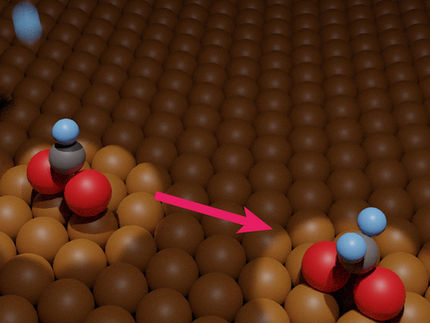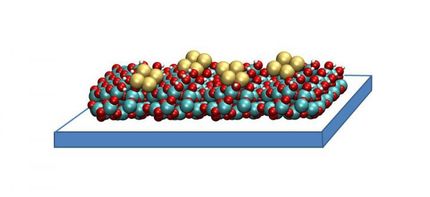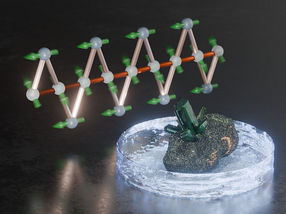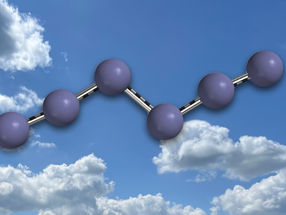Sunlight turns carbon dioxide to methane
Dual catalysts may be the key to efficiently turning carbon dioxide and water vapor into methane and other hydrocarbons using titania nanotubes and solar power, according to Penn State researchers.
"Recycling of carbon dioxide via conversion into a high energy-content fuel, suitable for use in the existing hydrocarbon-based energy infrastructure, is an attractive option, however the process is energy intense and useful only if a renewable energy source can be used for the purpose," the researchers note in Nano Letters.
Craig A. Grimes, professor of electrical engineering and his team used titanium dioxide nanotubes doped with nitrogen and coated with a thin layer of both copper and platinum to convert a mixture of carbon dioxide and water vapor to methane. Using outdoor, visible light, they reported a 20-times higher yield of methane than previously published attempts conducted in laboratory conditions using intense ultraviolet exposures.
The chemical conversion of water and carbon dioxide to methane is simple on paper - one carbon dioxide molecule and two water molecules become one methane molecule and two oxygen molecules. However, for the reaction to occur, at least eight photons are required for each molecule.
"Converting carbon dioxide and water to methane using photocatalysis is an appealing idea, but historically, attempts have had very low conversion rates," said Grimes who is also a member of Penn State's Materials Research Institute. "To get significant hydrocarbon reaction yields requires an efficient photocatalyst that uses the maximum energy available in sunlight."
The team, which also included Oomman K. Varghese and Maggie Paulose, Materials Research Institute research scientists and Thomas J. LaTempa, graduate student in electrical engineering, used natural sunlight to test their nanotubes in a chamber containing a mix of water vapor and carbon dioxide. They exposed the co-catalyst sensitized nanotubes to sunlight for 2.5 to 3.5 hours when the sun produced between 102 and 75 milliwatts for each square centimeter exposed.
The researchers found that nanotubes annealed at 600 degrees Celsius and coated with copper yielded the highest amounts of hydrocarbons and that the same nanotubes coated with platinum actually yielded more hydrogen, while the copper coated nanotubes produced more carbon monoxide. Both hydrogen and carbon monoxide are normal intermediate steps in the process and as the building blocks of syngas, can be used to make liquid hydrocarbon fuels.
When the team used a nanotube array with about half the surface coated in copper and the other half in platinum, they enhanced the hydrocarbon production and eliminated carbon monoxide. The yield for these dual catalyst nanotubes was 163 parts per million hydrocarbons an hour for each square centimeter. The yield from titania nanotubes without either copper or platinum catalysts is only about 10 parts per million.
"If we uniformly coated the surface of the nanotube arrays with copper oxide, I think we could greatly improve the yield," said Grimes. Grimes also found that lengthening the titanium dioxide tubes, which for other applications increases yield, does not improve results.
"We think that distribution of the sputtered catalyst nanoparticles is at the top surface of the nanotubes and not inside and that is why increased length does not improve the reaction," says Grimes.
Although all these experiments were done with nitrogen-doped titanium dioxide nanotubes, the researchers conclude that the nitrogen did not enhance the conversion of carbon dioxide to hydrocarbons. The catalysts, however, did shift the reaction from one that used only the energy in ultraviolet light to one that used other wavelengths of visible light and therefore more of the sun's energy.
The researchers are now working on converting their batch reactor into a continuous flow-through design that they believe will significantly increase yields. The researchers have filed a provisional patent on this work.
Most read news
Topics
Organizations
Other news from the department science

Get the chemical industry in your inbox
By submitting this form you agree that LUMITOS AG will send you the newsletter(s) selected above by email. Your data will not be passed on to third parties. Your data will be stored and processed in accordance with our data protection regulations. LUMITOS may contact you by email for the purpose of advertising or market and opinion surveys. You can revoke your consent at any time without giving reasons to LUMITOS AG, Ernst-Augustin-Str. 2, 12489 Berlin, Germany or by e-mail at revoke@lumitos.com with effect for the future. In addition, each email contains a link to unsubscribe from the corresponding newsletter.





























































